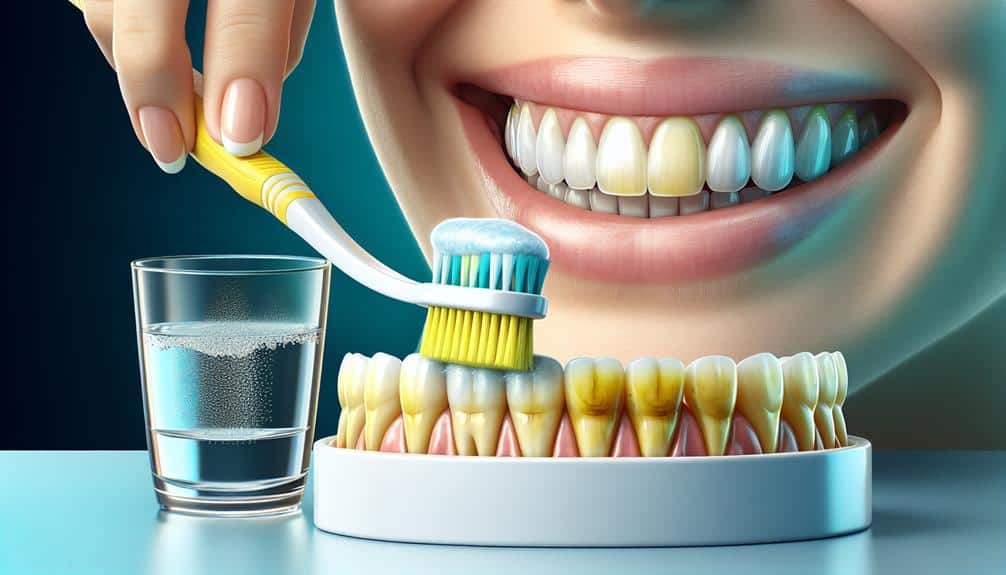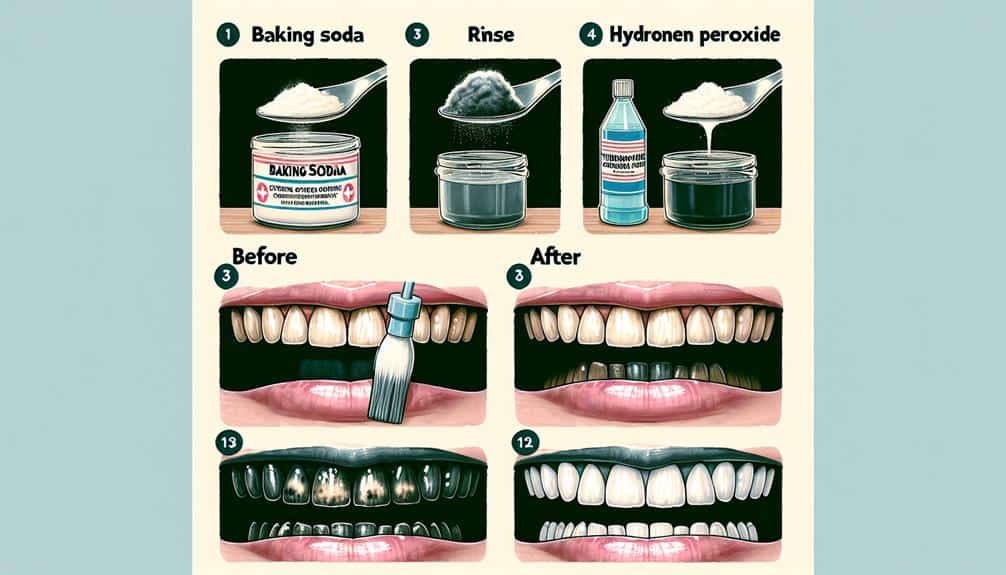For tackling stubborn tetracycline stains, consider professional teeth whitening for tailored treatment with higher whitening agent concentrations. Custom whitening trays, made specifically for your teeth, enhance the whitening process. At-home options like whitening strips can also be effective when used correctly, and whitening toothpaste containing key ingredients such as hydrogen peroxide or baking soda help remove surface stains effectively.
In-office whitening treatments provide immediate results with professional supervision. Alternative methods, such as LED whitening and natural remedies, offer additional options. Choosing the best whitening treatment can make a noticeable difference, ensuring a brighter smile.
Key Points
- Consider professional in-office whitening treatments for effective removal of tetracycline stains.
- LED teeth whitening can help break down stubborn tetracycline stains with consistent use.
- Charcoal whitening products are gentle on sensitive teeth and gums, suitable for tetracycline stains.
- Explore whitening gels known for their effective application techniques on tetracycline stains.
- Opt for peroxide treatments for deep tetracycline stains, ensuring thorough whitening results.
Professional Teeth Whitening
When considering whitening treatments for Tetracycline stains, professional teeth whitening offers effective and reliable results. Professional whitening benefits include the expertise of trained professionals who can tailor the treatment to your specific needs, guaranteeing excellent results. Unlike over-the-counter products, professional whitening treatments use higher concentrations of whitening agents, providing quicker and more noticeable results.
There are various professional whitening treatment options available to address Tetracycline stains. In-office whitening procedures involve the use of powerful whitening agents activated by special lights or lasers, delivering significant whitening in just one visit. Another option is at-home professional whitening kits provided by dentists, which offer custom-fit trays and professional-grade whitening gel for safe and effective results in the comfort of your home.
Professional teeth whitening not only effectively targets Tetracycline stains but also ensures that the procedure is carried out safely and under professional supervision, minimizing the risk of sensitivity or damage to your teeth and gums.
Custom Whitening Trays
Custom whitening trays are personalized dental trays designed to fit your teeth precisely for effective and comfortable at-home whitening treatments. These trays are tailored to your mouth's unique shape, ensuring ideal contact between the whitening gel and your teeth for superior results.
Here's what you need to know about custom whitening trays:
- *Tray customization*: Custom trays are made specifically for your teeth, ensuring a perfect fit that enhances the whitening process.
- *Tray effectiveness*: The customized fit of these trays allows the whitening gel to cover all surfaces of your teeth evenly, leading to more consistent and noticeable results.
- *Tray comfort*: Since custom trays are molded to fit your teeth precisely, they're more comfortable to wear compared to generic trays, reducing the likelihood of gum irritation.
- *Tray maintenance*: Proper care of your custom trays, such as regular cleaning and storing them in a safe place, is essential to prolong their lifespan and maintain their effectiveness.
Investing in custom whitening trays can provide you with a convenient and effective way to whiten your teeth at home while ensuring a comfortable experience.
Whitening Strips
When using whitening strips, make sure to follow the application tips for best results.
Remember to adhere to the recommended duration for strip usage to avoid potential side effects.
Always prioritize safety precautions to protect your oral health while using whitening strips.
Strip Application Tips
To achieve peak results with whitening strips, guarantee consistent and thorough application following these expert tips. When using whitening strips for tetracycline stain removal, strip effectiveness is key. Here are some essential strip application techniques to maximize your whitening results:
- Clean Teeth: Before applying the strips, make sure your teeth are clean and dry to enhance adherence.
- Proper Placement: Position the strips carefully to cover the stained areas adequately.
- Avoid Overlapping: Prevent overlapping of strips to ensure uniform whitening.
- Follow Instructions: Adhere strictly to the recommended duration and frequency for the best outcomes.
Duration for Use
For essential whitening results when using whitening strips to treat tetracycline stains, it's ideal to adhere strictly to the recommended duration of use. Consistency in the frequency of use is vital for achieving long-term results. Follow the instructions provided with the whitening strips to guarantee effectiveness over time.
Deviating from the recommended duration may not only hinder the whitening process but could also lead to unwanted side effects. Overuse of whitening strips can result in tooth sensitivity and gum irritation. By using the whitening strips as directed, you can maximize their effectiveness in treating tetracycline stains while minimizing the risk of adverse effects.
Safety Precautions
To guarantee the safe and effective use of whitening strips for treating tetracycline stains, it's essential to meticulously follow the recommended safety precautions provided by the manufacturer. When considering the use of whitening strips, it's important to understand precautionary measures to minimize potential side effects and ensure best results. Here are some key points to keep in mind:
- Conduct a thorough risk assessment before starting treatment.
- Adhere strictly to the recommended duration and frequency of use.
- Avoid using whitening strips excessively to prevent long-term effects on dental health.
- If you experience any adverse reactions or discomfort, discontinue use immediately and consult a dental professional for guidance.
Whitening Toothpaste
When contemplating whitening toothpaste, it's crucial to comprehend the key ingredients that contribute to their effectiveness. Various whitening toothpaste brands on the market contain components like hydrogen peroxide or baking soda that assist in removing surface stains for a brighter smile.
Understanding the components in whitening toothpaste can help in choosing the appropriate product to achieve the desired results.
Toothpaste Ingredients
In the quest for brighter smiles, understanding the key ingredients in whitening toothpaste is essential. When choosing a whitening toothpaste, look for formulations that provide enamel protection and offer fluoride benefits to strengthen your teeth. Additionally, consider options that prioritize sensitivity reduction while being mindful of abrasive ingredients that can help remove surface stains effectively.
Here are some essential components to look for in whitening toothpaste:
- Fluoride: Strengthens enamel and helps prevent tooth decay.
- Hydrogen Peroxide: Whitens teeth by breaking down stains.
- Potassium Nitrate: Reduces sensitivity by calming the nerves in your teeth.
- Silica: Acts as an abrasive to remove surface stains gently.
Selecting a whitening toothpaste with these ingredients can help you achieve a brighter, healthier smile.
Whitening Toothpaste Brands
Understanding the key ingredients in whitening toothpaste is essential when exploring different Whitening Toothpaste Brands. When searching for the best whitening toothpaste, consider options that offer sensitivity management and enamel protection.
Brands that incorporate fluoride can provide benefits such as strengthening enamel and preventing cavities. However, it's important to be cautious of the abrasiveness level of the toothpaste to avoid damaging the enamel. Look for reputable brands that have been clinically tested and approved by dental professionals for safe and effective whitening.
In-Office Whitening Treatments
For effective and promptly whitening results on tetracycline stains, consider opting for in-office whitening treatments. In-office whitening treatments offer professional solutions for deep stains and stubborn discoloration caused by tetracycline. Here are some key benefits of choosing in-office whitening treatments:
- Chairside Options: In-office whitening treatments provide chairside options where a dental professional oversees the entire process, ensuring safety and effectiveness.
- Bleaching Alternatives: Dentists can offer strong bleaching agents that aren't available for at-home use, allowing for more potent stain removal.
- Customized Treatment: Dental professionals can tailor the treatment to your specific needs, adjusting the intensity of the whitening agents to address the severity of tetracycline stains.
- Immediate Results: With in-office whitening treatments, you can experience immediate results in just one session, significantly brightening your smile and reducing the appearance of tetracycline stains.
LED Teeth Whitening
Consider exploring the innovative option of LED teeth whitening for tackling tetracycline stains and achieving a brighter, stain-free smile. LED whitening benefits include its effectiveness in breaking down stubborn stains caused by tetracycline, resulting in a whiter smile. This method is safe, quick, and painless, making it a popular choice for many individuals looking to improve the appearance of their teeth.
For those seeking convenience, there are also home LED options available. Home LED whitening kits provide a convenient way to whiten your teeth in the comfort of your own home. These kits typically include an LED light device and whitening gel that work together to brighten your smile over a series of treatments. While results may vary, many users have reported noticeable improvements in the whiteness of their teeth after consistent use.
Natural Whitening Remedies
Explore natural whitening remedies as effective alternatives for brightening teeth and reducing stains caused by tetracycline, providing a more holistic approach to achieving a whiter smile. When dealing with tetracycline stains, DIY remedies and herbal solutions can be valuable assets in your quest for a brighter smile.
Here are some natural whitening remedies to explore:
- Baking Soda: A gentle abrasive that can help scrub away surface stains.
- Coconut Oil Pulling: Swishing coconut oil in your mouth can help reduce bacteria and whiten teeth.
- Activated Charcoal: Known for its absorbent properties, it can bind to stains and toxins on the teeth.
- Strawberries: The malic acid in strawberries can naturally whiten teeth when mashed and applied to the surface.
These natural remedies offer a chemical-free way to address tetracycline stains and brighten your teeth. Incorporating these herbal solutions into your oral care routine can contribute to a healthier, whiter smile.
Whitening Gels
Whitening gels are popular products designed to effectively lighten teeth and reduce stains, offering a convenient and efficient solution for enhancing your smile. When using whitening gels, proper application techniques are important for best results. It's recommended to carefully follow the instructions provided with the gel to guarantee safe and effective usage.
Gel application techniques involve applying a thin layer of the gel to the surface of your teeth using the provided applicator or tray. It's important to avoid excess gel to prevent irritation to the gums and other soft tissues in the mouth. After application, the gel is usually left on for a specified amount of time before being rinsed off.
Studies have shown that whitening gels can be effective in reducing discoloration and improving the overall appearance of teeth. Gel effectiveness studies indicate that consistent use over a period of time can lead to noticeable results. Remember to consult with your dentist before starting any whitening treatment to ensure it's suitable for your dental health.
Charcoal Whitening Products
When considering whitening treatments for tetracycline stains, it's vital to evaluate the effectiveness of charcoal versus peroxide-based products.
Understanding the safety aspects of charcoal whitening products is essential before incorporating them into your dental care routine.
Make informed decisions by weighing the pros and cons of charcoal whitening products against traditional peroxide options.
Charcoal Vs. Peroxide
For effective removal of tetracycline stains, comparing the effectiveness of charcoal and peroxide whitening products can provide valuable insights into choosing the right treatment method. Charcoal whitening products offer natural benefits and gentle whitening action, while peroxide-based products are known for their effectiveness in breaking down tough stains.
Here are some key points to take into account when deciding between charcoal and peroxide whitening treatments:
- Charcoal products are gentle on sensitive teeth and gums.
- Peroxide treatments are effective at whitening deep stains caused by tetracycline.
- Charcoal whitening may take longer to show noticeable results.
- Peroxide products typically deliver quicker whitening outcomes.
Understanding these differences can help you select the most suitable whitening treatment for your tetracycline stains.
Charcoal Whitening Safety
Guaranteeing the safety of charcoal whitening products is paramount when considering their efficacy in treating tetracycline stains. Charcoal whitening benefits include its ability to absorb surface stains and toxins, resulting in a brighter smile. However, there are risks associated with charcoal whitening.
The abrasive nature of charcoal particles can potentially damage enamel and gums if not used correctly. Consulting with a dentist before using charcoal whitening products is crucial to ensure they're suitable for your oral health.
While charcoal whitening can be effective for some individuals, there are alternative whitening treatments available that may be safer and more suitable for long-term use. Consider discussing with your dentist to explore the most appropriate whitening options for your specific needs and concerns.
Laser Teeth Whitening
Laser teeth whitening is a highly powerful procedure that can greatly reduce or eliminate tetracycline stains, delivering noticeable results in just one session. This advanced treatment uses a laser to enhance the whitening effect of the bleaching agent, providing a more efficient and effective solution for stubborn stains.
Here are some key points to ponder when contemplating laser teeth whitening:
- Quick Results: Laser whitening can show immediate results after just one session.
- Precise Targeting: The laser can target specific areas, ensuring a more thorough and all-encompassing whitening effect.
- Reduced Sensitivity: Compared to other whitening methods, laser treatments may result in less tooth sensitivity.
- Professional Supervision: Laser whitening is typically performed by dental professionals, ensuring a safe and controlled environment.
When pondering laser whitening, it's crucial to weigh the benefits against the potential risks and the cost of the treatment. While it may be a more expensive option, the efficiency and immediate results can make it a worthwhile investment in achieving a brighter, stain-free smile.
Frequently Asked Questions
Are There Any Specific Foods or Drinks That Should Be Avoided to Prevent Further Staining While Undergoing Whitening Treatments for Tetracycline Stains?
To prevent further staining while whitening your teeth for tetracycline stains, it's important to follow dietary restrictions. Avoid stain-causing foods like coffee and red wine, opt for water instead of dark sodas, and limit acidic beverages that can erode enamel.
How Long Do the Results of Whitening Treatments for Tetracycline Stains Typically Last?
For tetracycline stain whitening, results' longevity varies. Regular maintenance like avoiding staining foods, using whitening toothpaste, and touch-up treatments can help extend the effects. Consult with your dentist for personalized advice on maintaining results.
Can Whitening Treatments for Tetracycline Stains Cause Sensitivity or Damage to the Teeth?
Can whitening treatments for tetracycline stains cause sensitivity or damage to the teeth? When considering potential side effects, some individuals may experience temporary tooth sensitivity. It's important to follow recommended guidelines to protect tooth enamel during whitening procedures.
Are There Any Alternative Treatments or Procedures That Can Effectively Address Tetracycline Stains Besides Whitening Treatments?
When looking to address tetracycline stains besides whitening treatments, consider alternative options like natural remedies or laser therapy. Cosmetic dentistry and microabrasion techniques are effective in managing these stains without relying solely on whitening treatments.
How Can I Maintain the Results of Whitening Treatments for Tetracycline Stains in the Long Term?
To maintain whitening treatment results for tetracycline stains long-term, combine home care like using whitening toothpaste with professional touch-ups and products. Regular dental visits for cleanings and touch-ups will help sustain your bright smile.



